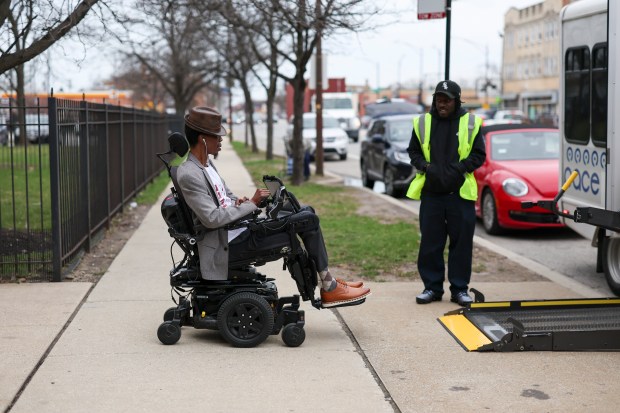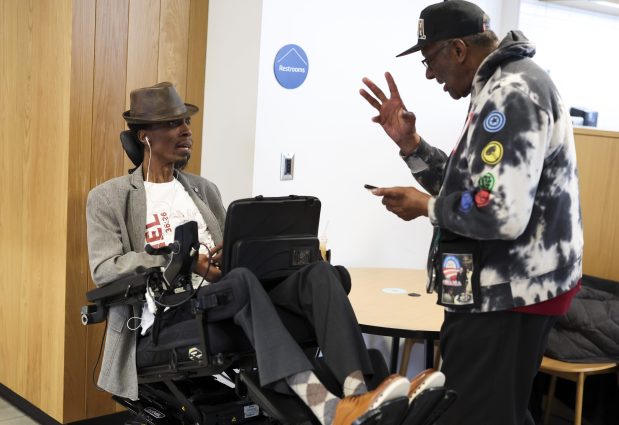When Nabi Yisrael left his Hyde Park apartment last year after his rent increased, he had to put most of his belongings into storage. The 51-year-old, who has multiple sclerosis and uses a power wheelchair to get around, didn’t have a home anymore.
For nearly six months since then, Yisrael bounced around between his friends and families’ apartments, carrying the necessities in a travel case — two pairs of jeans, a few pairs of shoes and five shirts, he said. For someone who prides himself on his fashion sense, it was a difficult transition.
“I’ve been wearing the same clothes since October,” Yisrael said in a recent interview. “Since October.”
About three months into essentially being homeless — for the first time in his life — Yisrael came to another difficult conclusion. Despite the “horror stories” he heard from friends about the conditions inside Chicago’s homeless shelters, particularly for people with disabilities, he decided he had no other choice but to seek placement at one. He needed a place to stay, and he needed it quickly, he said.
Yisrael contacted the Salvation Army in January and was told there were no available cots for him, he said. Two months later, when he called 311 for help finding an accessible shelter, he said the response was similar.
“A fox got its den. A bird got a nest,” he said, paraphrasing a Bible verse. “But a son of man got nowhere to lay his head.”
Disability and homeless advocates say Yisrael’s story — and that of another elderly couple living in their car — represents the nearly insurmountable challenges the city’s sizable homeless disabled population faces when trying to find shelter space, a problem they believe is getting worse.
The Disability Rights Action Coalition for Housing has a lawsuit against the city winding its way through federal court alleging the city doesn’t operate or design the emergency shelter program “in a manner that would provide equivalent services” to individuals with mobility disabilities.
“We’re talking about people with kind of common mobility challenges, and they’re being kept out of this system at this point,” said Charles Petrof, an attorney with the disability rights group Access Living, which is part of the lawsuit.
In response, a city spokesperson said the Department of Family and Support Services funds 11 shelters that are accessible under the Americans with Disabilities Act — and said all DFSS-funded shelters “must offer reasonable accommodations in accordance with Section 504 of the Rehabilitation Act of 1973.”
Expanding accessibility is a “long-standing goal” for the department and the city, the spokesperson said, adding that the department used federal money from the American Rescue Plan to improve shelter facilities, including ADA accessibility.
About 19% of Chicago’s adult homeless population — excluding migrants — reported having a physical disability, a 4% decrease compared with a year earlier, according to a 2024 report from the DFSS.
In that report, the city acknowledged that there’s “varied experiences for those in shelter versus on the street.” For example, 33.5% of people — excluding migrants — experience homelessness for a year or more if they are in a shelter. That percentage increased substantially to 67.8% for those not in a shelter.
‘I’ve been operating at 60%’
At the Hyde Park apartment Yisrael had lived in for about five years, he had a number of accessibility features that made life a bit easier — an elevator, a large bedroom and restroom and an outlet for his electric wheelchair, he said.
Access Living helped him find and move into this apartment using a housing voucher, a form of rental subsidy, in 2019. By that time his multiple sclerosis — a disease that affects the central nervous system — had progressed and he needed a home that was wheelchair accessible. Before, he was forced to “bump (himself) up the stairs.”
He had to leave, however, in October when his rent increased beyond the limits of his housing voucher, provided by the public housing authority. Finding another accessible apartment with a voucher is “terrible,” he said.
“It’s horrible. You got a voucher with my skin tone, in a wheelchair, it gives you like three strikes,” said Yisrael, who is Black.

Others have also reported difficulties finding places to live with housing vouchers. The Chicago Housing Authority has seen 61% to 77% of its voucher recipients able to lease a unit from 2019 to 2022. The rates are lower for 2023 and 2024 — 45% and 31%, respectively, but CHA said that’s because some of those recipients are still searching for units to rent, the Tribune reported last month.
After losing that apartment, Yisrael primarily stayed with a few family and friends, who couldn’t let him stay long-term due to their rental agreements and because their apartments aren’t accessible. In a pinch, he will spend his limited monthly income for a hotel stay.
A friend’s home that he lived in last month was particularly “challenging” to navigate, he said. It’s quite small, he said, and his friend had to physically pick him up out of his bed and put him in his wheelchair.
Twice, when he wasn’t sure he’d have anywhere else to go, he attempted to find space in a homeless shelter — once in January through the Salvation Army and once in March through 311. Both times, he said, he was told there wasn’t acceptable space for him after he explained his situation.
“My body’s shut down,” he said. “I’ve been operating at 60% — 60% Nabi.”
According to the city’s 311 service request database, Yisrael submitted a shelter request on March 6. It was closed on April 2. Fortunately, two days later, he signed a lease and received keys for a new apartment using his housing voucher. He’s hoping to move his belongings in soon after he deals with some health issues, he said.
The Salvation Army partners with the city to match individuals and families to shelter, said organization spokesperson Brian Duewel. He said there are limited beds for singles in the shelter system and that it’s “very likely” Yisrael wasn’t placed when he made the request.
“When a client calls and states they need an accessible shelter placement, we contact the accessible shelters and, most times, the beds are full,” he said.

Despite the difficult circumstances from the past six months, Yisrael said he tries to keep a positive outlook. After being diagnosed with MS in 2009, it took him almost a decade to accept his disability and the “whole new world” he entered, he said.
Yisrael enjoys reading and listening to motivational quotes on YouTube, including one by Martin Luther King Jr. — “If you can’t fly, then run. If you can’t run, then walk. If you can’t walk, then crawl, but whatever you do, you have to keep moving forward.”
Yisrael also expresses himself through fashion — he wore a brown jacket, slacks and a bowler hat at a recent interview — and through writing. One day, he said he hopes to turn his life story into a play.
“People just need to spend a week in a chair, just one week,” he said. “I bet their perception will change.”
Lawsuit against city
Petrof, the attorney at Access Living, helped file a lawsuit about five years ago against the city on behalf of Gloria Carter, alleging she was denied access to the city’s emergency shelter program because her disability prevented her from climbing stairs and into vans. Carter, who has osteoarthritis, uses a walker to move around, the suit said.
A similar lawsuit filed in 2019 also accused Chicago’s shelter system of failing to provide accommodations mandated by federal law.
Petrof also said people in shelters tend to have a better shot at getting into the city’s housing assistance programs. Being cut off from the first rung of the ladder will prohibit or slow down their road to being rehoused, he said.
Bridget Hayman, the communication director at Access Living, added that true accessibility at shelters involves both its “physical structure” and “the way it operates.” For example, someone like Yisrael would need his personal care assistant to be allowed in a shelter, she said.
“There are people that can walk in the door and still not get the full care they need and deserve,” she said.
‘High-risk’ situation
In Monica Dillon’s experience, it’s fairly common for people with disabilities to seek help accessing a shelter. The first thought that runs through her mind when she meets them, the nurse and volunteer with Northwest Side Homeless Outreach said, is: “Oh my heavens, where are we going to get shelter?”
In December, Dillon received a referral to help out a couple, a 78-year-old woman and a man in his 60s who had been living in a truck after they were unexpectedly evicted from their apartment, at which point she said she emailed DFSS officials about the “high-risk” situation. About 7% of the homeless population, excluding migrants, in Chicago is 65 and older, according to the 2024 report.
The woman, who asked that her name not be shared for privacy and health concerns, said she prayed every day that the truck wouldn’t break down, because they’d have nowhere else to go.
“I’m an old lady. Never in my life did I expect something quite like this to happen,” she told the Tribune in February.
When the woman learned in December that there were open slots at the city’s new “shelter placement and resource center,” she agreed to try it out, even though she had some worries about her safety.
At the shelter, she said she was separated from her partner, who helps her move around along with a wheelchair and other mobility aids. The only beds available, she said, were cots a few inches off the ground. Worried that she wouldn’t be able to stand back up with her “bad legs,” she decided to sit and sleep in a folding chair.

The woman said she had no choice but to leave the next morning and return to the truck, where she then waited more than 50 days for an accessible shelter bed. When one didn’t become available, outreach workers raised money for a week-long temporary motel stay.
“Every morning, I say, ‘Thank you, Jesus, we’re still here and let’s hope for better things to come,’” she said. “I say a little prayer.”
After their one-night stay at SPARC didn’t work out, Dillon put in a 311 request for shelter, which she said was closed “all of a sudden” a couple of weeks later.
“She didn’t receive any phone calls, letting her know that there was no shelter available, or that her service request was closed,” Dillon said.
A city spokesperson said SPARC, a 200-bed facility in Pilsen that opened late last year after the city closed its migrant “landing zone,” has ADA-compliant accommodations in its daytime lounge area, showers and bathroom. The facility connects single adults to available beds throughout the shelter system and isn’t intended to be a long-term placement, the spokesperson added.
However, if someone isn’t placed in a shelter by late in the evening, the facility offers overflow beds through cots, the spokesperson said. The city, including the Mayor’s Office of People with Disabilities, is “working with delegate agencies” at the facility to provide access to ADA-accessible cots, which must have a height of 17 to 19 inches, the spokesperson said.
“DFSS is committed to ensuring that homeless services are accessible to all people experiencing homelessness,” the spokesperson said.
Multiple subsequent 311 requests for shelter beds went unanswered, Dillon said. The most recent request, submitted on Jan. 31, remained open until March 3, according to the city’s 311 service request database. She began telling the woman’s story publicly at a City Council meeting in February and in a letter to the editor in the Sun-Times, hoping to find a solution as temperatures dropped.
“It started to impact both of their health. It’s very difficult to live in a truck, especially as you get older,” Dillon said. “It impairs circulation, leaves them at higher risk for clots … because they can’t really move around and elevate their feet.”
About six weeks ago, the woman and her partner were able to move into a medical respite in the suburbs, Dillon said. This facility, Dillon said, is a better fit. A nurse comes in multiple days per week and there’s more support for her mobility disabilities, she said.
The program will also allow her to stay for around two years, Dillon said. However, the arduous steps to find this housing is still mind-boggling to Dillon, and she said she hopes there are solutions moving forward.
“She’s in shelter, and that we’re grateful for,” Dillon said. “But she really does need accessibility to deeply affordable housing.”





